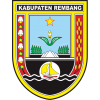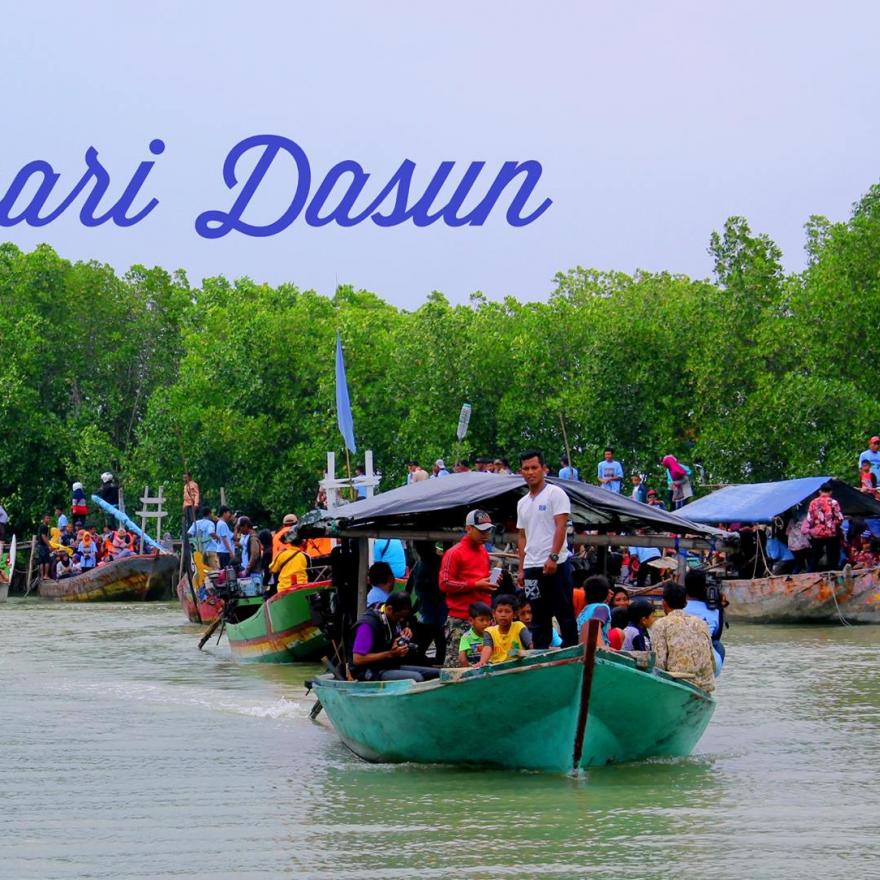Dasun-rembang.desa.id-Patience matters: Women workers of a batik factory, Pusaka Beruang in Lasem, Rembang regency, Central Java, are engrossed in making batik. Patience is highly needed to make batik.
In the past, the village of Dasun (Desa Dasun), Lasem district, Rembang regency, Central Java, was the center for the engineering and construction of big ships. Some village elders even said they had been there when the village had been the production center for big ships when the country was still under the occupation of the Japanese military.
The Japanese chose Desa Dasun to construct their ships as it is situated near the sea. The village is located near the Lasem River that flows through Lasem, which is an old town rich in stories of past glories.
“We realized that our village had the potential for tourism. However, we didn’t have money to develop it. It was in 2015 that the idea to build a tourist village became stronger. Gradually, we went ahead with the plan. We used some of the money from the village fund (from the central government) to build the supporting infrastructure,” Desa Dasun’s village head, Sujarwo, told The Jakarta Post on Sunday.
The shipping industry in Desa Dasun during the Dutch occupation is well documented on media.kitlv.nl. Locals believe that the industry can be traced all the way back to the Majapahit Kingdom of the 14th and 15th centuries.
The village’s rich history is a strong incentive to entice visitors. Moreover, the remains of the shipyards and docks can still be seen. Also, the majority of the villagers are fishermen and many fishing boats can be seen along the shore.
“We take tourists on boat trips on the Lasem River whose other name is the Dasun River. They can go all the way to the sea to enjoy the beautiful sunsets or head to Chinatown in Lasem.
“We also have mangrove forests on the left and right sides of the river and the air is fresh. It’s really alluring,” said Exan Ali, one of the tourist workers in Desa Dasun.
Indonesia’s great writer, Pramoedya Ananta Tour, even mentioned Desa Dasun and its docks in his book, Jalan Raya Pos, Jalan Daendels ( 2005 ).
The remains of the docks are still there. In the area, tourists can still find the foundations of three docks. Two pillars can be found on the banks of the Dasun-Lasem River, the other one is at Lasem Beach, which is located about 1 kilometer from the other two.
These three pillars are in the shape of a half ship. They are made of cement cast mixed with stones, gravel and sea sand. The remains of a sluice gate made of teak once stood in the river. However, the teak disappeared few years ago, presumably taken by a villager.
At the time, the people did not understand that it had huge historical value. The gate comprised four teak boards of around 4 square meters set in a line. People said the boards were stolen and sold.
Sujarwo said boat rides on the river was very popular with local tourists.
 Oldest Chinese temple: Chinese Temple Cu An Kiong, the oldest temple in Lasem, Rembang, is located on Jl. Dasun, Soditan village. The temple reportedly adopts a Fujian architectural style.
Oldest Chinese temple: Chinese Temple Cu An Kiong, the oldest temple in Lasem, Rembang, is located on Jl. Dasun, Soditan village. The temple reportedly adopts a Fujian architectural style.
“In the high season, 500 tourists visit us. We utilize the fishing boats to take them on trips. The cost for one trip is Rp 700,000 (US$48) on a big boat and Rp 500,000 on a small one. More than 10 people can get on one boat, so the price is very affordable,” he added.
Village funds are around Rp 780 million per year and the village administration set aside some of it to build a warung apung (a floating store and restaurant) on the river’s banks. It is managed by a village-owned enterprise and serves various types of food, which are the specialty of the village and the region.
You can find urap latoh, a mainstay in the area. It is a dish made of seaweed with grated coconut and eaten with fish. The taste is specific and certainly delicious.
There are also diverse dishes with milkfish or chicken as the main ingredient. For drinks, tourists can opt for tea, coffee or fruit juice.
Handmade batik
Aside from marine tourism, Desa Dasun also offers trips to the local Chinatown in Lasem. Tourists can get off near Cun An Kiong temple, which is said to be one of the oldest temples on Java Island.
From there, they can proceed to Omah Lawang Ombo (Lawang Ombo House), which is located on Jl. Dasun in the village of Saditan. Lawang Ombo is a big house with Chinese architecture, which was once an opium warehouse.
The house has a tunnel connecting it to the river. Opium would enter Lasem from China and it would then be taken to Lawang Ombo through the underground tunnel.
In Chinatown, there is also a red house that the locals refer to as Little China. It is located in the village of Karangturi. The red house belongs to Rudi Hartono, a rich businessman in Lasem. He had the house renovated and made into a tourist attraction.
In 2016, the villagers in Karangturi established Kelompok Sadar Wisata (the Tourism Awareness Group). The group has been helping to manage the tourism industry in the village, including promoting the red house and, thus, helping to make it into a popular tourist destination.
“With Chinatown in Lasem getting more popular, handmade batik from Lasem has also enjoyed increased popularity. A handmade batik producer reported that his sales doubled because of the impact of tourism,” said Harjono, Kecamatan Lasem’s head.
So, today, visiting Chinatown and shopping for handmade batik are packaged with Desa Dasun tourism.
Lasem has 20 villages, each with their own specialty. “We encourage the village administrations to showcase their village’s tourism potential. To learn to manage the industry, I invited the village heads and staff to a village in Umbul Ponggok, Klaten. There, they learned firsthand how to manage the tourism sector from the management of the popular Umbul Ponggok,” he explained.
Umbul Ponggok is a big natural spring, which has been Klaten’s leading tourist attraction.
In Desa Dasun, villagers are ready to become tourist guides, and for accommodation, tourists can stay at homestays managed by the villagers. “We asked the locals to manage the tourism industry in their own village,” said Sujarwo.
 Breathtaking river: Travelers enjoy the beauty of the Lasem village area (left and right). Travelers can traverse the path, starting from the urban area to the coastal area or vice versa, to enjoy the beauty of the river.
Breathtaking river: Travelers enjoy the beauty of the Lasem village area (left and right). Travelers can traverse the path, starting from the urban area to the coastal area or vice versa, to enjoy the beauty of the river.
Sumber Artikel : The Jakarta Post
https://www.thejakartapost.com/news/2018/09/04/desa-dasun-from-shipping-marine-tourism.html
=============================================
Terjemahan bebas dari Google Terjemahan:
Oleh Suherdjoko
Masalah kesabaran: Pekerja wanita dari sebuah pabrik batik, Pusaka Beruang di Lasem, Kabupaten Rembang, Jawa Tengah, asyik membuat batik. Kesabaran sangat dibutuhkan untuk membuat batik.
Di masa lalu, desa Dasun (Desa Dasun), kabupaten Lasem, Kabupaten Rembang, Jawa Tengah, adalah pusat untuk rekayasa dan konstruksi kapal besar. Beberapa tetua desa bahkan mengatakan bahwa mereka ada di sana ketika desa itu menjadi pusat produksi kapal-kapal besar ketika negara itu masih di bawah pendudukan militer Jepang.
Jepang memilih Desa Dasun untuk membangun kapal mereka karena letaknya dekat laut. Desa ini terletak di dekat Sungai Lasem yang mengalir melalui Lasem, yang merupakan kota tua yang kaya akan kisah-kisah kejayaan masa lalu.
“Kami menyadari bahwa desa kami memiliki potensi untuk pariwisata. Namun, kami tidak punya uang untuk mengembangkannya. Itu pada 2015 bahwa ide untuk membangun desa wisata menjadi lebih kuat. Secara bertahap, kami melanjutkan rencana itu. Kami menggunakan sebagian uang dari dana desa (dari pemerintah pusat) untuk membangun infrastruktur pendukung, ”kata kepala desa Desa Dasun, Sujarwo, kepada The Jakarta Post, Minggu.
Industri perkapalan di Desa Dasun selama pendudukan Belanda didokumentasikan dengan baik di media.kitlv.nl. Penduduk setempat percaya bahwa industri ini dapat dilacak sampai ke Kerajaan Majapahit pada abad ke 14 dan 15.
Sejarah desa yang kaya adalah insentif kuat untuk memikat pengunjung. Apalagi sisa-sisa galangan kapal dan dermaga masih bisa dilihat. Juga, sebagian besar penduduk desa adalah nelayan dan banyak perahu nelayan terlihat di sepanjang pantai.
“Kami membawa wisatawan dalam perjalanan perahu di Sungai Lasem yang namanya lain adalah Sungai Dasun. Mereka dapat pergi jauh-jauh ke laut untuk menikmati matahari terbenam yang indah atau pergi ke Chinatown di Lasem.
“Kami juga memiliki hutan bakau di sisi kiri dan kanan sungai dan udaranya segar. Benar-benar memikat, ”kata Exan Ali, salah satu pekerja wisata di Desa Dasun.
Penulis hebat Indonesia, Pramoedya Ananta Tour, bahkan menyebut Desa Dasun dan dok-doknya di bukunya, Jalan Raya Pos, Jalan Daendels (2005).
Sisa-sisa dermaga masih ada di sana. Di kawasan itu, wisatawan masih bisa menemukan fondasi tiga dermaga. Dua pilar dapat ditemukan di tepi Sungai Dasun-Lasem, yang lainnya di Pantai Lasem, yang terletak sekitar 1 kilometer dari dua lainnya.
Ketiga pilar ini berbentuk setengah kapal. Mereka terbuat dari semen yang dicampur dengan batu, kerikil dan pasir laut. Sisa-sisa gerbang pintu air yang terbuat dari kayu jati pernah berdiri di sungai. Namun, jati itu menghilang beberapa tahun yang lalu, mungkin diambil oleh seorang penduduk desa.
Pada saat itu, orang-orang tidak mengerti bahwa itu memiliki nilai sejarah yang sangat besar. Gerbang terdiri dari empat papan jati sekitar 4 meter persegi yang ditetapkan dalam satu garis. Orang-orang mengatakan papan itu dicuri dan dijual.
Sujarwo mengatakan naik perahu di sungai sangat populer di kalangan wisatawan lokal.
Kuil Tiongkok tertua: Kuil Cina Cu An Kiong, candi tertua di Lasem, Rembang, terletak di Jl. Dasun, desa Soditan. Kuil itu kabarnya mengadopsi gaya arsitektur Fujian.
“Di musim ramai, 500 wisatawan mengunjungi kami. Kami menggunakan kapal penangkap ikan untuk membawanya dalam perjalanan. Biaya untuk satu perjalanan adalah Rp 700.000 (US $ 48) untuk kapal besar dan Rp 500.000 untuk kapal kecil. Lebih dari 10 orang bisa naik satu perahu, sehingga harganya sangat terjangkau, ”tambahnya.
Dana desa sekitar Rp 780 juta per tahun dan pemerintah desa menyisihkan sebagian darinya untuk membangun warung apung (toko apung dan restoran) di tepi sungai. Dikelola oleh perusahaan milik desa dan menyajikan berbagai jenis makanan, yang merupakan spesialisasi desa dan daerah.
Anda dapat menemukan urap latoh, andalan di daerah tersebut. Ini adalah hidangan yang terbuat dari rumput laut dengan kelapa parut dan dimakan bersama ikan. Rasanya spesifik dan pasti enak.
Ada juga beragam hidangan dengan bandeng atau ayam sebagai bahan utamanya. Untuk minuman, wisatawan dapat memilih teh, kopi, atau jus buah.
Batik buatan tangan
Selain wisata bahari, Desa Dasun juga menawarkan perjalanan ke Chinatown lokal di Lasem. Wisatawan dapat turun di dekat candi Cun An Kiong, yang dikatakan sebagai salah satu candi tertua di Pulau Jawa.
Dari sana, mereka dapat melanjutkan ke Omah Lawang Ombo (Rumah Lawang Ombo), yang berlokasi di Jl. Dasun di desa Saditan. Lawang Ombo adalah rumah besar dengan arsitektur Cina, yang dulunya merupakan gudang opium.
Rumah itu memiliki terowongan yang menghubungkannya dengan sungai. Opium akan memasuki Lasem dari Cina dan kemudian akan dibawa ke Lawang Ombo melalui terowongan bawah tanah.
Di Chinatown, ada juga rumah merah yang disebut penduduk lokal sebagai Little China. Terletak di desa Karangturi. Rumah merah itu milik Rudi Hartono, seorang pengusaha kaya di Lasem. Dia memiliki rumah yang telah direnovasi dan dijadikan objek wisata.
Sungai yang mempesona: Wisatawan menikmati keindahan daerah desa Lasem (kiri dan kanan). Wisatawan dapat melintasi jalan setapak, mulai dari daerah perkotaan hingga daerah pantai atau sebaliknya, untuk menikmati keindahan sungai.
Foto oleh JP / Suherdjoko


